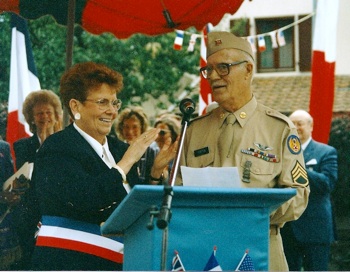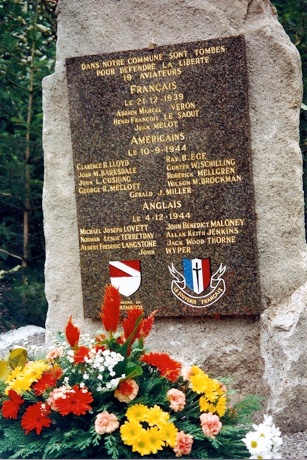A Piece of History
World War 1939–1945
With its French-speaking citizens, Barembach was deeply involved in this war : (1) the village lay between two German concentration and death camps, the only ones erected in France, one on the Struthof and the other in Schirmeck-La Broque, (2) three aircraft crashes occurred, 19 members of the crews were killed, (3) as a site of anti-aircraft batteries, the village endured attacks by allied fighter-bombers, (4) Marshal Jean de Lattre de Tassigny installed his headquar-ters in the village at the beginning of 1945 (as reminded by a monument near the war memorial).
Gene FORTON speaking during the ceremonies of September 10, 1994. To the left, Mrs. Geneviève WERNERT, mayor of Barembach at that time.
Barembach suffered under German occupation from June 21 or 22, 1940 until November 24, 1944. While the declaration of war had occurred as early as September 3, 1939, only on December 21 did I witness the first fight, between a French twin-motor plane and a German fighter. The French, hit, went into a dive with its engines roaring, then straightened up as if trying to land on the flat part of the Grand Rain hill, but struck the edge of the forest, then located over the dyke north to GR5 trail. The 3 aviators, found dead, were buried in the village's graveyard. Toward the end of the war, with German batteries in and around the village, an American bomber B24H ("Flying Fortress") was hit on September 10, 1944, and crashed with its full load of incendiary bombs on the street Heydé. An old, sick woman was killed in her bed and nine houses were destroyed. The only, safe survivor of the crew, Albert Eugene ("Gene") FORTON, used his parachute, but he was caught soon after his landing and put into the camp of Schirmeck-La Broque,and later on transfered to another camp in Germany, where he was freed in 1945. After the Liberation, on the evening of December 4, 1944, an English Lancaster bomber en route to Germany collided with another plane and crashed into the small valley called Basse du Boucher, exploding with his 7-member crew. On the whole, 19 aviators were killed in Barembach during that war.
Inquiries held by a Dutch patriot, Mr. MESDAG, who had witnessed the crash of the B24 from the camp of the Struthof as a prisonner, helped by other historians like Mr. Francis MULLER (Strasbourg), finally succeeded in identifying Mr. FORTON in 1993. Being informed of Mr. FORTON being still alive in his country, the mayor of Barembach, Mrs. Geneviève WERNERT, decided to celebrate the 50th anniversary of this event and, at the same time, of the Liberation, on September 10, 1994. She gave this event an exceptional solemnity. Mr. FORTON was present with his family, as well as Mr. MESDAG. He unvailed a stela engraved with the names of his 19 comrades fallen on duty, in the "Forton Square", rue du Heydé, where his memory will keep alive.
The stela erected to the memory of the 19 aviators who fell in Barembach. To the left, the arms of Barembach and, right, those of the Souvenir Français, a patriotic association.
The first book on the Struthof (format PDF, 38 Mo)
Le Struthof, camp de la mort
by Albert HORNUNG
Jean-Paul Hornung, 2010. – Le journal d’un fils écrit par son père… L’Essor, Schirmeck, n° 277 (septembre 2010), p. 42–46.


